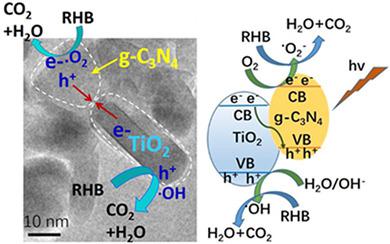当前位置:
X-MOL 学术
›
J. Chin. Chem. Soc.
›
论文详情
Our official English website, www.x-mol.net, welcomes your
feedback! (Note: you will need to create a separate account there.)
Construction of direct Z‐scheme g‐C3N4/TiO2 nanorod composites for promoting photocatalytic activity
Journal of the Chinese Chemical Society ( IF 1.6 ) Pub Date : 2019-07-15 , DOI: 10.1002/jccs.201900135 Mei Liu 1 , Shaojie Wei 1 , Wei Chen 1, 2 , Li Gao 1 , Xiying Li 1 , Liqun Mao 1 , Haifeng Dang 3
Journal of the Chinese Chemical Society ( IF 1.6 ) Pub Date : 2019-07-15 , DOI: 10.1002/jccs.201900135 Mei Liu 1 , Shaojie Wei 1 , Wei Chen 1, 2 , Li Gao 1 , Xiying Li 1 , Liqun Mao 1 , Haifeng Dang 3
Affiliation

|
Direct Z‐scheme g‐C3N4/TiO2 nanorod composites were prepared for enhancing photocatalytic activity for pollutant removal. The characterization revealed that the g‐C3N4/TiO2 nanorod composite formed a close interface contact between g‐C3N4 and TiO2 nanorods, which was of benefit for the charge transfer and resulted in its high photocatalytic activity. The g‐C3N4/TiO2 nanorod composites exhibited higher photocatalytic activity for degradation of Rhodamine B (RHB) than bare g‐C3N4 and TiO2 nanorods. The high photocatalytic activity of g‐C3N4/TiO2 nanorod composites is attributed to the formation of the direct Z‐scheme system, in which the electrons from the conduction band (CB) of TiO2 combine with the holes from the valence band (VB) of C3N4 while the electrons from the CB of C3N4 and holes from the VB of TiO2 with stronger redox ability are used to reduce and oxidize pollutants. Based on the radical‐trapping experiments, the main reactive species for RHB degradation are O2− and ·OH, which are produced by photoinduced electrons and holes with high redox ability. This work provides insights into the photocatalytic mechanism of composite materials for the photocatalytic removal of organic pollutants.
中文翻译:

直接Z方案g-C3N4 / TiO2纳米棒复合材料的构建以提高光催化活性
准备直接Z方案g‐C 3 N 4 / TiO 2纳米棒复合材料以增强光催化活性以去除污染物。表征表明,g‐C 3 N 4 / TiO 2纳米棒复合材料在g‐C 3 N 4和TiO 2纳米棒之间形成了紧密的界面接触,这有利于电荷转移并使其具有较高的光催化活性。g‐C 3 N 4 / TiO 2纳米棒复合材料对罗丹明B(RHB)的降解表现出比裸g‐C 3 N 4高的光催化活性。和TiO 2纳米棒。g‐C 3 N 4 / TiO 2纳米棒复合材料的高光催化活性归因于直接Z方案体系的形成,其中TiO 2的导带(CB)中的电子与价态的空穴结合C 3 N 4的能带(VB),而来自C 3 N 4的CB的电子和氧化还原能力更强的TiO 2的VB的空穴用于还原和氧化污染物。基于所述自由基捕获实验,对于RHB降解的主要反应性物质为O 2 -和·OH,由具有高氧化还原能力的光生电子和空穴产生。这项工作提供了对复合材料的光催化机理进行光催化去除有机污染物的见解。
更新日期:2020-02-14
中文翻译:

直接Z方案g-C3N4 / TiO2纳米棒复合材料的构建以提高光催化活性
准备直接Z方案g‐C 3 N 4 / TiO 2纳米棒复合材料以增强光催化活性以去除污染物。表征表明,g‐C 3 N 4 / TiO 2纳米棒复合材料在g‐C 3 N 4和TiO 2纳米棒之间形成了紧密的界面接触,这有利于电荷转移并使其具有较高的光催化活性。g‐C 3 N 4 / TiO 2纳米棒复合材料对罗丹明B(RHB)的降解表现出比裸g‐C 3 N 4高的光催化活性。和TiO 2纳米棒。g‐C 3 N 4 / TiO 2纳米棒复合材料的高光催化活性归因于直接Z方案体系的形成,其中TiO 2的导带(CB)中的电子与价态的空穴结合C 3 N 4的能带(VB),而来自C 3 N 4的CB的电子和氧化还原能力更强的TiO 2的VB的空穴用于还原和氧化污染物。基于所述自由基捕获实验,对于RHB降解的主要反应性物质为O 2 -和·OH,由具有高氧化还原能力的光生电子和空穴产生。这项工作提供了对复合材料的光催化机理进行光催化去除有机污染物的见解。









































 京公网安备 11010802027423号
京公网安备 11010802027423号